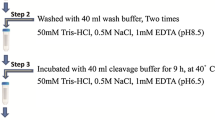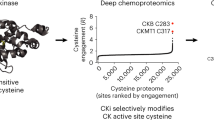Abstract
Creatine kinase isoform CK-MB has been widely applied as a biomarker of myocardial injury. While a variety of methods have been used to measure CK-MB activity or mass in clinical laboratories, a CK-MB standard is needed to eliminate between-method bias. Because the in vitro expression of human creatine kinase generates three isoenzymes, CK-MM, CK-MB, and CK-BB, it is important to establish an effective method to purify the isoform CK-MB from the mixture. In this study, we aimed at using tandem affinity purification (TAP) to purify recombinant CK-MB protein and evaluate its value in clinical laboratories. After the optimized sequence coding CK-M and CK-B were synthesized, they were combined with TAP tags (6His and SBP) and inserted into a pRSFDuet vector; then, the constructed 6His-CK-M-SBP-CK-B-pRSF plasmid was transformed into Escherichia coli BL21 (DE3) for expression. After TAP, we obtained purified CK-MB protein. We also did recovery testing using the engineered CK-MB and standard CK-MB (Randox) at different concentrations, and the results suggested that the engineered CK-MB could be used as the reference material. Moreover, the stability study of recombinant CK-MB showed high stability during long-term storage at −80 °C. In conclusion, the TAP-purified recombinant CK-MB protein may be a much better and cheaper standard or reference material for clinical laboratories.





Similar content being viewed by others
References
Apple FS, Wu AH, Jaffe AS, Panteghini M, Christenson RH (2008) National Academy of Clinical Biochemistry and IFCC Committee for Standardization of Markers of Cardiac Damage Laboratory Medicine practice guidelines: analytical issues for biomarkers of heart failure. Clin Biochem 41(4–5):222–226
Bailey D, Urena L, Thorne L, Goodfellow I (2012) Identification of protein interacting partners using tandem affinity purification. J Vis Exp 25(60):3643–3648
Christenson RH, Vaidya H, Landt Y, Bauer RS, Green SF, Apple FA, Jacob A, Magneson GR, Nag S, Wu AH, Azzazy HM (1999) Standardization of creatine kinase-MB (CK-MB) mass assays: the use of recombinant CK-MB as a reference material. Clin Chem 45(9):1414–1423
Dati F, Panteghini M, Apple FS, Christenson RH, Mair J, Wu AH (1999) Proposals from the IFCC Committee on Standardization of Markers of Cardiac Damage (C-SMCD): strategies and concepts on standardization of cardiac marker assays. Scand J Clin Lab Invest Suppl 230:113–123
Grossman SH, Sellers DS (1998) Subunit conformation and dynamics in a heterodimeric protein: studies of the hybrid isozyme of creatine kinase. Biochim Biophys Acta 1387(1–2):447–453
Ikura T, Ogryzko VV, Grigoriev M, Groisman R, Wang J, Horikoshi M, Scully R, Qin J, Nakatani Y (2000) Involvement of the TIP60 histone acetylase complex in DNA repair and apoptosis. Cell 102(4):463–473
Jaruvongvanich V, Rattanadech W, Damkerngsuntorn W, Jaruvongvanich S, Vorasettakarnkij Y (2015) CK-MB activity, any additional benefit to negative troponin in evaluating patients with suspected acute myocardial infarction in the emergency department. J Med Assoc Thail 98(10):935–941
Kitzenberg D, Colgan SP, Glover LE (2016) Creatine kinase in ischemic and inflammatory disorders. Clin Transl Med 5(1):31
Li Y, Franklin S, Zhang MJ, Vondriska TM (2011) Highly efficient purification of protein complexes from mammalian cells using a novel streptavidin-binding peptide and hexahistidine tandem tag system: application to Bruton’s tyrosine kinase. Protein Sci 20(1):140–149
Mariman EC, Broers CA, Claesen CA, Tesser GI, Wieringa B (1987) Structure and expression of the human creatine kinase B gene. Genomics 1(2):126–137
McLeish MJ, Kenyon GL (2005) Relating structure to mechanism in creatine kinase. Crit Rev Biochem Mol Biol 40(1):1–20
Nakatani Y, Ogryzko V (2003) Immunoaffinity purification of mammalian protein complexes. Methods Enzymol 370:430–444
Puig O, Caspary F, Rigaut G, Rutz B, Bouveret E, Bragado-Nilsson E, Wilm M, Seraphin B (2001) The tandem affinity purification (TAP) method: a general procedure of protein complex purification. Methods 24(3):218–229
Rigaut G, Shevchenko A, Rutz B, Wilm M, Mann M, Seraphin B (1999) A generic protein purification method for protein complex characterization and proteome exploration. Nat Biotechnol 17(10):1030–1032
Ritter CS, Mumm SR, Roberts R (1981) Improved radioimmunoassay for creatine kinase isoenzymes in plasma. Clin Chem 27(11):1878–1887
Saks V, Kaambre T, Guzun R, Anmann T, Sikk P, Schlattner U, Wallimann T, Aliev M, Vendelin M (2001) The creatine kinase phosphotransfer network: thermodynamic and kinetic considerations, the impact of the mitochondrial outer membrane and modelling approaches. Subcell Biochem 46:27–65
Sánchez M, Gella FJ, Profilis C, Ceriotti F, Cuso E, Fuentes-Arderiu X, Hallermayer K, Horder M, Panteghini M, Schumann G, Canalias F (2001) Certification of the mass concentration of creatine kinase isoenzyme 2 (CK-MB) in the reference material BCR 608. Clin Chem Lab Med 39(9):858–865
Siekmann L, Bonora R, Burtis CA, Ceriotti F, Clerc-Renaud P, Férard G, Ferrero CA, Forest JC, Franck PF, Gella FJ, Hoelzel W, Jørgensen PJ, Kanno T, Kessner A, Klauke R, Kristiansen N, Lessinger JM, Linsinger TP, Misaki H, Mueller MM, Panteghini M, Pauwels J, Schiele F, Schimmel HG, Vialle A, Weidemann G, Schumann G, International Federation of Clinical Chemistry and Laboratory Medicine (2002) IFCC primary reference procedures for the measurement of catalytic activity concentrations of enzymes at 37 degrees C. International Federation of Clinical Chemistry and Laboratory Medicine. Part 7. Certification of four reference materials for the determination of enzymatic activity of gamma-glutamyltransferase, lactate dehydrogenase, alanine aminotransferase and creatine kinase accord. Clin Chem Lab Med 40(7):739–745
Sunahara Y, Uchida K, Tanaka T, Matsukawa H, Inagaki M, Matuo Y (2001) Production of recombinant human creatine kinase (r-hCK) isozymes by tandem repeat expression of M and B genes and characterization of r-hCK-MB. Clin Chem 47(3):471–476
Acknowledgements
This work was supported by the National Natural Science Foundation of China (Grant 81400036 and Grant 81571384).
Author information
Authors and Affiliations
Corresponding author
Ethics declarations
Conflict of interest
The authors declare that they have no conflict of interest.
Ethical approval
This article does not contain any studies with human participants or animals performed by any of the authors.
Rights and permissions
About this article
Cite this article
Zou, L., Su, W., Wang, M. et al. Characterization of a functional recombinant human creatine kinase-MB isoenzyme prepared by tandem affinity purification from Escherichia coli . Appl Microbiol Biotechnol 101, 5639–5644 (2017). https://doi.org/10.1007/s00253-017-8286-5
Received:
Revised:
Accepted:
Published:
Issue Date:
DOI: https://doi.org/10.1007/s00253-017-8286-5




